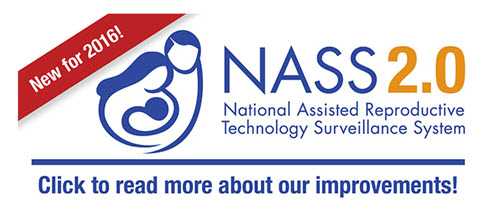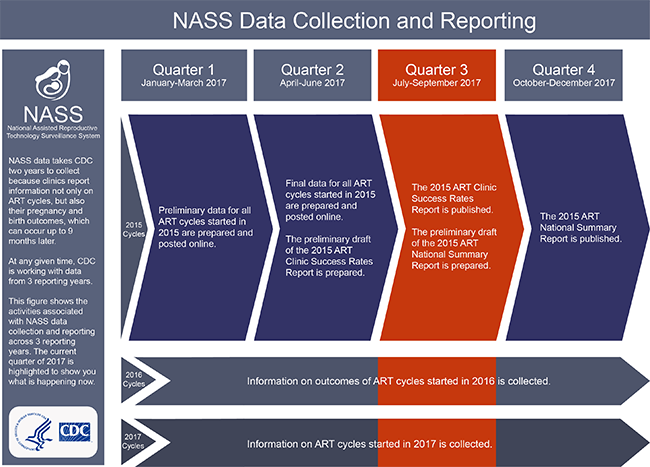National ART Surveillance
Why Do We Monitor Assisted Reproductive Technology?

In the United States, over 440 clinics provide services to patients seeking to overcome infertility. CDC collects the data from all fertility clinics in the United States and calculates standardized success rates for each clinic. This gives a potential ART user an idea of their average chances of success. While ART relieves the burden of infertility for many couples, it presents significant public health challenges due to the substantial risk for multiple birth delivery, which is associated with poor maternal and infant health outcomes. For this reason, it is important to monitor the safety and effectiveness of ART procedures in the United States.
How Do We Monitor Assisted Reproductive Technology?
NASS Data Collection Infographic
According to the Fertility Clinic Success Rate and Certification Act, all ART cycles performed in United States fertility clinics are reported to CDC. National ART Surveillance System (NASS) is supported by the Division of Reproductive Health, National Center for Chronic Disease Prevention and Health Promotion, Centers for Disease Control and Prevention, U.S. Department of Health and Human Services, under contract, currently with Westat, Inc. NASS is the only CDC-approved data reporting system for ART procedures. CDC (through contract with Westat, Inc) and the Society for Assisted Reproductive Technology (SART) maintain a list of all ART clinics known to be in operation and tracks clinic reorganizations and closings. NASS data include—
- Patient demographics.
- Patient obstetrical and medical history.
- Parental infertility diagnosis.
- Clinical parameters of the ART procedure.
- Information regarding resultant pregnancies and births.
When drawing conclusions from NASS data, it is important to consider that data are cycle-specific, and data from women who undergo multiple cycles in one year are unlinked. Each year, a small number of clinics do not report data to CDC, and are listed as non-reporters in the ART Report. Because most non-reporting clinics are small, we estimate that NASS contains information about more than 95% of all ART cycles in the United States.
In addition to providing consumers with information about national and clinic-specific pregnancy success rates, national ART surveillance allows for the assessment of infant outcomes (birth weight, plurality, maturity), and the monitoring of trends in ART use in the United States.
ART surveillance data are protected under 308(d) Assurance of Confidentiality. Because of this Assurance, all data files are considered confidential materials and are safeguarded to the greatest extent possible.
Data Submission
ART clinics that are submitting data to CDC via the National ART Surveillance System (NASS) reporting system or through an approved alternative will be considered to be in compliance with federal reporting requirements of the FCSRCA. CDC’s NASS is a Web-based ART data reporting system. Clinics either electronically enter or import data into NASS for each ART procedure they start in a given reporting year. SART-member clinics may report their data to NASS through SART.
Representatives of a new clinic preparing to submit ART data or an existing clinic with data submission questions, can contact NASS Help Desk by calling 1-888-650-0822.
How Do We Ensure Data Accuracy?
Clinics are required to verify all reported data. CDC conducts data validation through yearly audits and site visits. To have their success rates published in this annual report, clinics’ medical directors must verify by signature that the tabulated success rates are accurate. The submitted data are then reviewed, and clinics are contacted if corrections are necessary.
After the data have been verified, a quality control process called validation begins. Every year, a sample of reporting clinics is selected for data validation. Members of the validation team visit selected clinics and review medical record data for a sample of the clinic’s ART cycles. For each cycle, the validation team compares information abstracted from the patient’s medical record with the data submitted for the report. Validation primarily helps ensure that clinics are being careful to submit accurate data. It also serves to identify any systematic problems that could cause data collection to be inconsistent or incomplete.
What Improvements Does NASS 2.0 Bring?
In 2016, an updated version of the National ART Surveillance System, NASS 2.0, opened. ART data collection required a number of improvements to continue accurately reporting on ART practices and outcomes. These needs stemmed from rapid changes in the field of ART, where new treatment methods and approaches are quickly adapted. Examples of changes made to the surveillance system include changes to variables, definitions, and reporting requirements (especially prospective reporting), improved functionality that allows users to link information on oocyte retrievals and embryo transfers, and improved security and a streamlined user interface. CDC made changes to ART data collection in collaboration with many stakeholders, from professional societies, such as the American Society for Reproductive Medicine (ASRM), the Society for Assisted Reproductive Technology (SART), and the American Urological Association (AUA), and to consumer organizations, such as RESOLVE—the National Infertility Association, and Path2Parenthood.
Publications and Research
CDC uses NASS data to publish annual ART Reports. These reports contain ART success rates for individual fertility clinics and a national summary, as well as information about the factors that contribute to success and trends of ART use.
In addition, CDC’s Division of Reproductive Health developed an ART research program. This research provides evidence that can be used to make public health recommendations and health care practice recommendations. It can also help individual providers and patients make informed decisions about infertility treatment and services.
States Monitoring ART (SMART) Collaborative
Because NASS only contains limited pregnancy outcome information, CDC initiated a collaborative project to link ART surveillance data with other surveillance systems and registries that contain more detailed information on women and infants. In collaboration with the health departments of Connecticut, Massachusetts, Michigan, and Florida, NASS data are being linked to vital records, hospital discharge data, birth defects registries, cancer registries, and other surveillance systems of these states. This project, the States Monitoring ART (SMART) Collaborative, provides a unique opportunity to establish state-based patient-focused (versus cycle-focused) public health surveillance of ART, infertility and related issues.
CDC is also collaborating with SART, the Boston University School of Public Health, and the Massachusetts Department of Public Health to support the Massachusetts Outcomes Study of ART (MOSART) project. This project links the SART database with multiple record systems maintained by the Commonwealth of Massachusetts and may also provide a rich source of information on the outcomes of ART.
History of ART Surveillance
1978—The first IVF birth in the world was reported in England.
1981—The first IVF birth in the United States was reported.
1986—The Society for Assisted Reproductive Technology (SART) was established in the early 1980’s, and began to collect data from its member clinics in 1986.
1992—The Federal Trade Commission intervened in a case of false advertising by a fertility clinic. As a result, the Fertility Clinic Success Rate and Certification Act of 1992 FCSRCA), Section 2(a) of P.L. 102–493 (42 U.S.C. 263a-1(a)) was passed, which mandated that CDC collect information yearly about ART cycles performed at clinics in the United States.
1997—CDC collaborated with SART to publish the first ART Success Rates Report to describe ART procedures performed in 1995.
2001—CDC began linking ART data with state surveillance data, which later developed into the States Monitoring ART (SMART) Collaborative.
2002—CDC published the first ART Surveillance Summary in the Morbidity and Mortality Weekly Report (MMWR), which reports ART use and outcomes by state.
2004—CDC started development on the National ART Surveillance System (NASS). This builds on previous data collection systems and implements CDC model standards for surveillance.
2006—NASS was launched.
2016—NASS 2.0 goes live, bringing a number of improvements to the system.
CDC partners include the American Society for Reproductive Medicine (ASRM) and the Society for Assisted Reproductive Technology (SART), who are involved in framing the surveillance and research questions and in collecting and reporting data from member clinics. Other important partners who represent consumers of ART and infertility services include RESOLVE, Path 2 Parenthood, and Livestrong Fertility. These organizations provide ongoing consultations about the ART Report and its use for public health communications and education.
Related Links
- U.S. Department of Health and Human Services’ National Library of Medicine
The National Library of Medicine’s, MedlinePlus, offers information on infertility including drugs and medications, medical terms, and other resources for care, support, and decision making. - Clinicaltrials.gov
The U.S. Department of Health and Human Services maintains this registry of federally and privately supported clinical trials conducted in the United States and around the world. Searching the ClinicalTrials.gov database gives you information about a trial’s purpose, who may participate, locations, and contact information to obtain more details about clinical trials on infertility and related health problems. - Society for Assisted Reproductive Technology
The Society for Assisted Reproductive Technology (SART) promotes and advances the standards for the practice of assisted reproductive technology to the benefit of patients, members and society at large. - American Society for Reproductive Medicine
The American Society for Reproductive Medicine (ASRM) is a multidisciplinary organization for the advancement of information, education, advocacy and standards in the field of reproductive medicine. - Path 2 Parenthood
- RESOLVE: The National Infertility Association
RESOLVE is a national consumer organization that offers support for men and women dealing with infertility. Their purpose is to provide timely, compassionate support and information to people who are experiencing infertility and to increase awareness of infertility issues through public education and advocacy. - Livestrong Fertility
- American Urological Association Foundation
The American Urological Association Foundation provides educational services and referrals to benefit patients with male infertility.
- Page last reviewed: July 19, 2017
- Page last updated: July 19, 2017
- Content source:
- Maintained By:


 ShareCompartir
ShareCompartir
